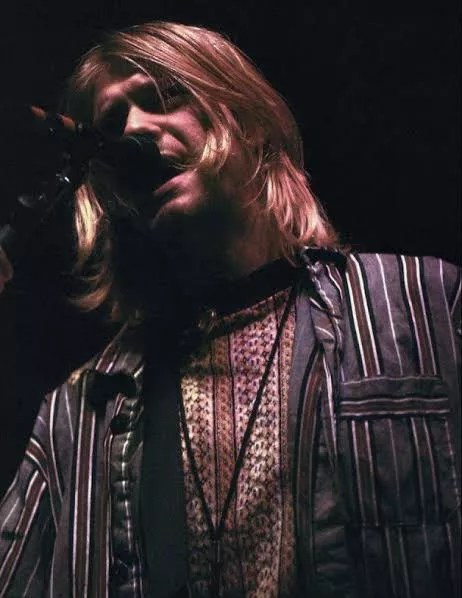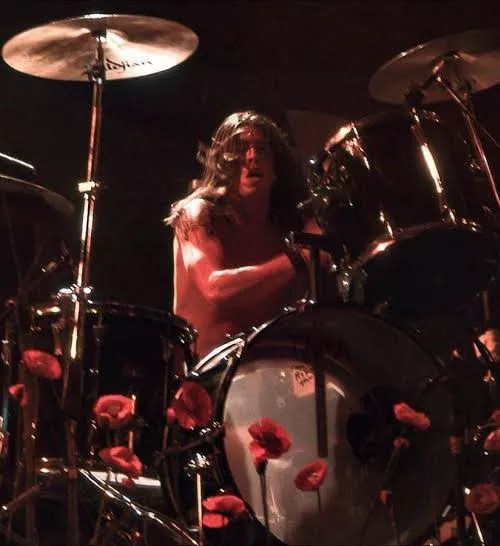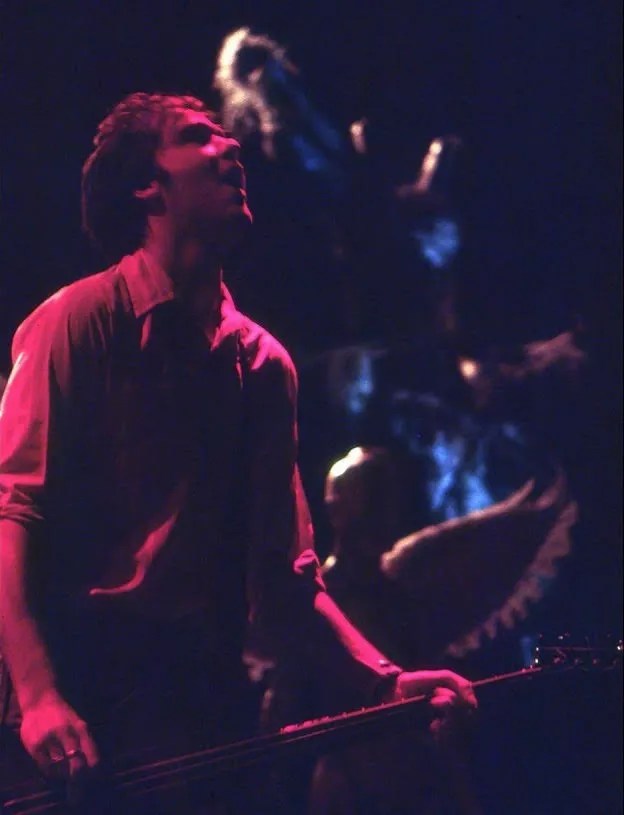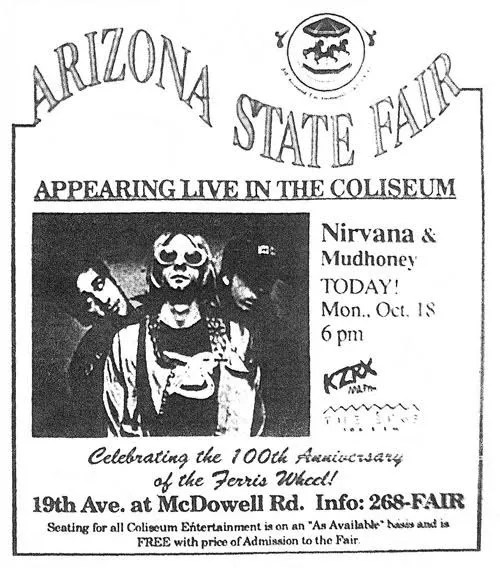
Lissa Wales

Audio By Carbonatix
Kurt Cobain was unimpressed when he took the stage inside the Arizona Veterans Memorial Coliseum at the Arizona State Fairgrounds in Phoenix on Oct. 18, 1993.
It was only the first show of Nirvana’s lengthy “In Utero” tour, but the singer-songwriter had already been given a reason to feel disgruntled. At least the new set looked cool.
Nirvana had decided to use a few elaborate props on stage for the first time in the band’s existence for what would be the first large-scale arena tour they had ever embarked on. The set had been decorated with some ornamental flowers and peculiar-looking fake trees. There were also two mannequins on stage, both reproductions of the transparent, anatomical angel-winged female image from the cover of the “In Utero,” the band’s third album. The record had debuted at number one on the U.S. Billboard chart in September 1993 and was mostly met with critical acclaim.
For all his band’s success, the 26-year-old Cobain was disheartened and felt the need to set some of his audience straight when he approached the microphone with one of his Fender guitars that Monday night in Phoenix.
We’re thankful for you. Are you thankful for us?
We feel thankful for our staff and for the privilege of fulfilling our mission to be an unparalleled source of information and insight in Phoenix. We’re aiming to raise $30,000 by December 31, so we can continue covering what matters most to this community.
Help us continue giving back to Phoenix.
Thousands of Arizonans had just booed Mudhoney and chanted for Nirvana during the opening band’s set. Clearly, those people in the audience didn’t know Mudhoney were “the best band in Seattle,” as Cobain had described them to Geffen Records executive Gary Gersh. The wonderfully irreverent Mark Arm and his bandmates had been blowing people’s hair back and causing chaotic mosh pits with their raw, high-energy music back when Cobain had barely settled on a name for his own band in the late 1980s.
Cobain hated the kind of rednecks he had grown up around in Aberdeen, Wash., and there were clearly a few of those macho types among the Arizona State Fair crowd. Perhaps some of the people packed inside the Veterans Memorial Coliseum should have just attended the Billy Ray Cyrus concert held in the same venue the previous night, rather than a punk-inspired alternative-rock show.
Nirvana, Mudhoney and their respective road crews had arrived at the coliseum to begin their load-in around 9 a.m. The 15,000-seat arena was sold out for the eagerly anticipated show that night, which was sponsored by alternative radio station KZRX/100.3, often referred to as “Z-Rock.”
The building Nirvana and Mudhoney were loading their gear into had originally opened back on Nov. 23, 1965. The first rock concert held beneath its notoriously leaky roof had been performed by The Monkees on Jan. 27, 1967. The Doors had played the arena twice in 1968. The Rolling Stones had performed there on Nov. 11, 1969. Elvis Presley had appeared on stage inside the coliseum twice during the early 1970s. The building also hosted plenty of hockey games and had until the previous year been home court for the Phoenix Suns. The artistic Cobain presumably glanced at Phoenix artist Paul Coze’s series of murals inside the coliseum. He also noticed on the marquee that the country songstress he jokingly referred to as “Arriba McEntire” would be singing there in a couple of days.
While the coliseum had hosted plenty of rock concerts throughout the previous decades, it was not the kind of building in which Nirvana and Mudhoney were accustomed to playing. With the exception of a handful of festivals and larger venues, both bands had spent years mostly playing in much smaller clubs or modest theaters. Cobain was still coming to grips with the kind of arena-rock expectations that had been thrust upon him following the breakthrough success of Nirvana’s monumental second album, “Nevermind,” in fall 1991.
The reality of playing venues like the Veterans Memorial Coliseum often conflicted with his punk rock values. His band may have sold millions of records and even displaced Michael Jackson at the top of the U.S. Billboard charts almost two years earlier, but Nirvana didn’t consider themselves rock stars; rather, they were the disaffected but often humorous “grunge” rockers whose emergence from the underground music scene had shot holes in the dominance of the preening, prancing, grossly commercial hair bands of the 1980s.

Dave Grohl pounds the drums during Nirvana’s 1993 Phoenix concert.
Lissa Wales
Cobain, bass player Krist Novoselic, drummer Dave Grohl and their new rhythm guitarist, Pat Smear, familiarized themselves with the acoustics inside the Veterans Memorial Coliseum during their sound check around 2 p.m.
The Arizona State Fair was in full swing while the band prepared for the show. Many parents and thrilled youngsters were taking their turn riding the nearby 164-foot-tall Ferris wheel. The ongoing festivities had kicked off that morning with the Arizona High School Rodeo in the Grandstand Arena. The St. John’s High School marching band had paraded down the nearby Avenue of Flags and Lights at 11 a.m., and a Scottish alternative rock band called Texas played a set at the Arizona Lottery Stage at 1:30 that afternoon. American bushman Kachunga and his fighting alligator appeared twice that day over at the Adventure Arena.
Nirvana were finally ready to take the stage inside the Arizona Veterans Memorial Coliseum around 7 p.m. following Mudhoney’s poorly received opening set. All eyes were focused on the stage, and thousands roared their approval when the band emerged, with the screaming reaching a fever pitch when the slender lead singer and guitarist with his stringy blond hair first came into view.
“He didn’t know that he was a better-looking guy than Brad Pitt,” Cobain’s wife, Courtney Love, later professed.
Seated in the second tier of the coliseum that night was an Arizona historian, KSLX radio personality and future owner of True West magazine, Bob Boze Bell, who had brought his young son to his first concert. Ten-year-old Tom Bell had been somewhat confused during Mudhoney’s set, having mistaken them for the headline act and suggesting they leave when the opening band left the stage.
“He was, of course, then blown away by Kurt Cobain,” Bob Bell recalls. The Nirvana frontman would also shock many of the attendees by scolding them for having booed Mudhoney before blowing anyone away with his own music.
After admonishing some of his audience, Cobain proceeded to whip many of them into a frenzy by thrashing his guitar strings and screaming his lungs out as his band opened their set with the abrasive “Radio Friendly Unit Shifter.” The young members of the crowd began bouncing around and slam-dancing on the arena floor as a swirling mosh pit emerged front and center among the standing attendees.
“I remember at looking at the mosh pit from the balcony and thinking, man, those guys are tough doing that,” Tom Bell recalls.
The more passionate Nirvana fans inside the coliseum frequently sang along with the band throughout the show, providing an extra collective voice to Cobain’s occasionally cryptic, sometimes sarcastic and often brutally honest lyrics.
“Kurt also complained a lot about his band and how he might leave them,” Bob Bell says. “I thought that was weird stage banter, but having been in bands most of my life, I got the stressors.”

Bassist Krist Novoselic joked with the crowd during the show.
Lissa Wales
Nirvana tore through “Drain You,” a song inspired by unrequited love, and an aggressive number called “Breed,” before playing a subdued rendition of “Serve the Servants” for the Arizona crowd. “Teenage angst has paid off well, now I’m bored and old,” Cobain sang.
The band were not used to seeing themselves on a Jumbotron overhead.
“I felt like a fucking hockey player on a big screen with a Budweiser sign above it,” drummer Dave Grohl later said.
The tempo picked up again as many in the audience sang along with Cobain as the band played an inspired rendition of “About a Girl,” a song Cobain had written about an old girlfriend from their first album, “Bleach.”
Nirvana’s lanky bass player and unofficial stand-up comedian Novoselic joked with the crowd a little before the band played their latest single, “Heart-Shaped Box,” which one Cobain biographer has described as the songwriter’s magnum opus. Cobain switched Fender guitars before they played “Sliver,” after which Novoselic made a crack about a show they had played with Seattle band Tad in front of a minuscule crowd at The Mason Jar in Phoenix back in 1990.
“We had to pay rent on the microphones,” Novoselic told the crowd, referring to the club’s tight-fisted owner, Franco Gagliano.
The band then played “Dumb,” a softer, melodic composition off “In Utero,” followed by their hit singles “In Bloom” and “Come As You Are.” Next, almost the entire crowd belted out the words to “Lithium” along with Cobain, who next poured plenty of anguish into his vocals when they played “Pennyroyal Tea” and a furious rendition of “School.” The band’s friend Lori Goldstein joined in on cello as Nirvana treated the crowd to an acoustic rendition of “Polly,” a song about a true story of kidnapping, rape and torture that Cobain had once read about. The audience lapped it up.
Novoselic was amused by so many of the Arizona crowd holding up their cigarette lighters during the show, which was an uncommon occurrence at a Nirvana concert.
“You’re supposed to save the lighters for ‘Dream On,'” the bass player said jokingly, referring to the Aerosmith song. He then comically sang a couple of lines in horrendous fashion. Cobain followed this by playfully singing a few lines from the 4 Non Blondes hit song “What’s Up?,” provoking some high-pitched squeals from the audience.
“This is an avant-garde number,” Cobain informed the crowd before they played the offbeat “Milk It,” during which the singer screamed so furiously that his voice cracked and almost blew out toward the end of the song. Nirvana then performed a blistering rendition of their anti-rape song “Rape Me.”

A promotional flyer for the concert.
Arizona State Fair
The lead singer’s voice cracked again while singing the chorus of “Territorial Pissings,” before the band played their most famous song, “Smells Like Teen Spirit,” for the appreciative Arizonan faithful. Cobain deliberately messed up the guitar solo and nobody seemed to care.
Nirvana then left the stage after playing the sublime “All Apologies,” only to return several minutes later by popular demand and perform an encore consisting of the grinding “Blew” and their heaviest number of all, “Endless, Nameless.”
The band then began wildly smashing their instruments and amplifiers as the crowd cheered them on. Cobain had sarcastically played the strands of a Led Zeppelin solo in reference to Nirvana’s new status as an arena rock band and attacked one of the winged mannequins with his guitar. He then gently dived into the Arizonan crowd, which proved a mistake when the songwriter was almost torn by pieces by some overexcited fans.
“They immediately just started grabbing for me and trying to rip my flesh off for souvenirs,” Cobain later said.
“Kurt did a crowd surf with the audience holding him up and passing him around in a big circle,” Bob Bell recalls. “It seemed very dangerous to me, but he pulled it off.”
Cobain made it out of the crowd alive and headed backstage with his bandmates before the largely satisfied Arizona faithful began slowly filing out of the coliseum.
“Of course, I got the T-shirt and the CD and I wish I still had both,” Tom Bell says.
Nirvana did a sit-down interview backstage for MTV News following the show in which the band casually discussed their concerns about playing in larger venues and talked about some of their experiences. Arizona may have been a primarily conservative state, but there had still been some of the usual high-jinks from the more mischievous young attendees inside the coliseum. Dave Grohl had been hit in the head with a stick at one point. Pat Smear was amused when someone in the audience threw a Germs T-shirt at him in reference to the guitarist’s former punk rock band. Some shoes were also tossed onto the stage, and Cobain recalled a bra being thrown in his direction that night.
The interview wound down with Cobain being asked about his overhyped “feud” with Pearl Jam singer Eddie Vedder.
“We never had a fight ever, I just have always hated their band,” Cobain replied with a mischievous grin.
Nirvana and Mudhoney left Phoenix to play a show the following night in Albuquerque, N.M., but Nirvana would never complete their scheduled “In Utero” tour. Having spiraled deeper into clinical depression, heroin addiction and frustration with the course of his music career, Cobain would end his own life with a shotgun on April 5, 1994. He remains a symbol of empathy, fascination and creative inspiration for millions of disaffected youth almost three decades later.
“It’s hard for me to walk down the street and not see a Nirvana shirt every single frickin’ day,” the late songwriter’s daughter, Frances Bean Cobain, recently said.
Nirvana’s concert at the Arizona Veterans Memorial Coliseum wasn’t the greatest show they ever played, but the legendary grunge band made a profound impact on many of the Arizonans in attendance, none more so than young Tom Bell.
“Nirvana stands the test of time,” says the now-39-year-old, who was inspired by the band to become the punk rock enthusiast he remains today. “They were so simple. So pure. So much energy.”
Thousands of other young Arizonans readily agreed with him that memorable night.